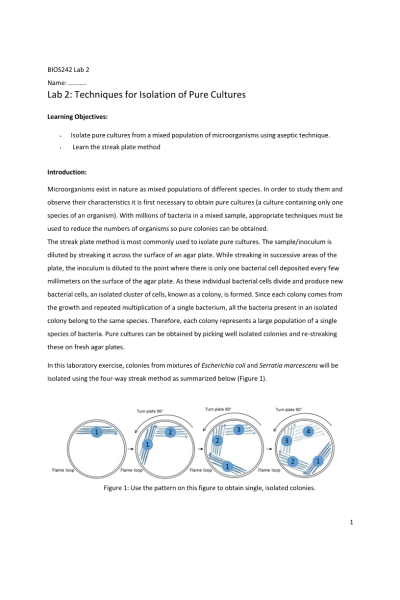BIOS 242 Week 1 Assignment; Lab 2 of 14 Onsite - Isolation of Pure Cultures
-
$20.00
| Institution | Chamberlain |
| Contributor | Nikki |
Document Preview
Lab 2: Techniques for Isolation of Pure Cultures
Learning Objectives:
- Isolate pure cultures from a mixed population of microorganisms using aseptic technique.
- Learn the streak plate method
Introduction:
Microorganisms exist in nature as mixed populations of different species. In order to study them and observe their characteristics it is first necessary to obtain pure cultures (a culture containing only one species of an organism). With millions of bacteria in a mixed sample, appropriate techniques must be used to reduce the numbers of organisms so pure colonies can be obtained.
The streak plate method is most commonly used to isolate pure cultures. The sample/inoculum is diluted by streaking it across the surface of an agar plate. While streaking in successive areas of the plate, the inoculum is diluted to the point where there is only one bacterial cell deposited every few millimeters on the surface of the agar plate. As these individual bacterial cells divide and produce new bacterial cells, an isolated cluster of cells, known as a colony, is formed. Since each colony comes from the growth and repeated multiplication of a single bacterium, all the bacteria present in an isolated colony belong to the same species. Therefore, each colony represents a large population of a single species of bacteria. Pure cultures can be obtained by picking well isolated colonies and re-streaking these on fresh agar plates.
In this laboratory exercise, colonies from mixtures of Escherichia coli and Serratia marcescens will be isolated using the four-way streak method as summarized below (Figure 1).
Instituition / Term
Term
Summer
Institution
Chamberlain
Contributor
Nikki






























































































